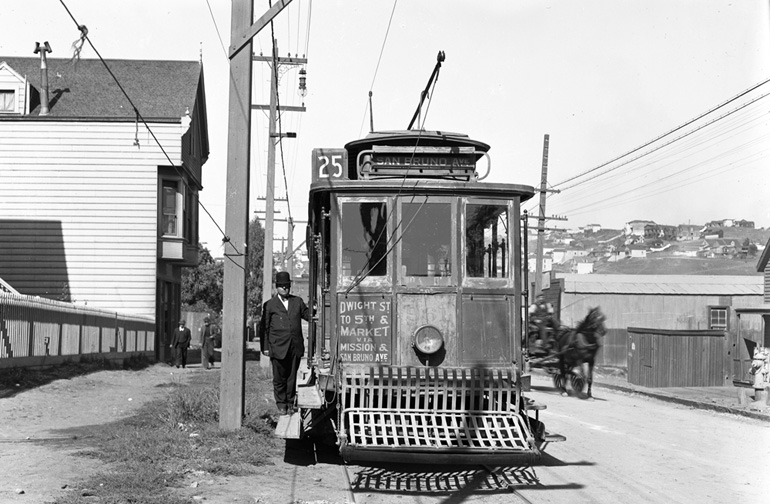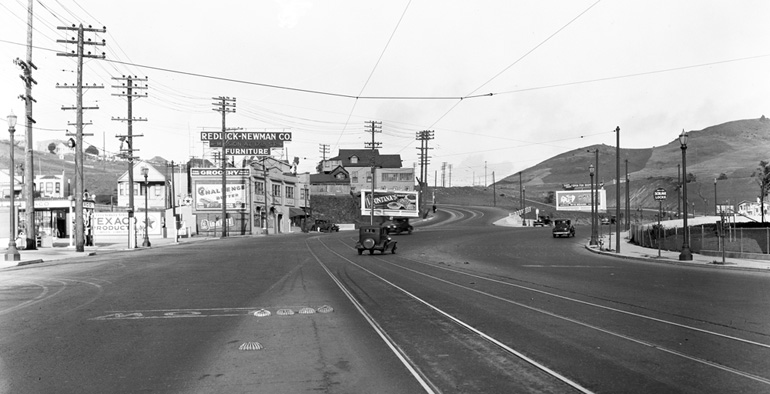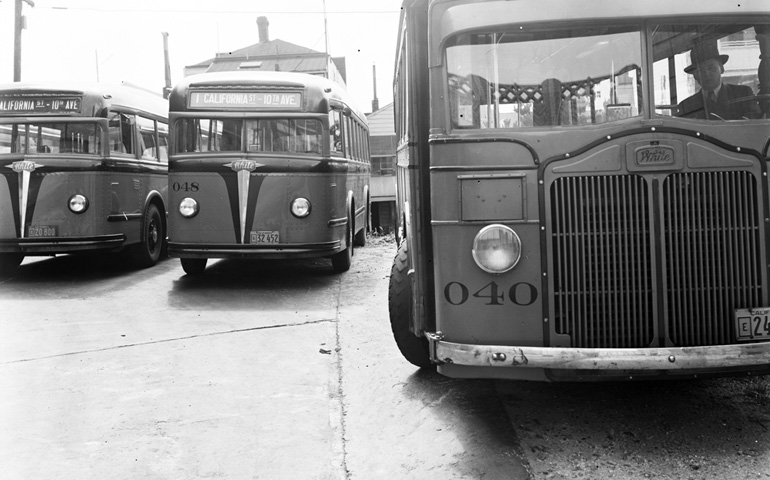A Historic Line - The Fine 9 San Bruno
The SFMTA Photo Archive has been spending the past few weeks diving into the history of some of San Francisco's most historic transit routes. Last week we took a look at the 14 Mission Yesterday, Today and Tomorrow, and the week before we kicked off the series with the history of transit on Geary, including the 38 bus route and some of the Municipal Railway's oldest streetcar lines.
Today we’re looking at one of SF’s hardest working routes: the 9-San Bruno bus and the 9R, or 9 Rapid. Combined, these two lines on any given weekday have an average of about 18,800 people boarding per day. It may surprise some Muni riders to learn that transit routes through the Mission and down Bayshore Boulevard and San Bruno Avenue have been in operation for more than 100 years. San Bruno Avenue routes have their origins in two historic lines, one of which dates all the way back to 1899.

The charming, electric-powered streetcar in this 1911 photograph of the San Bruno Line resembles the ones you see now on Market Street’s F Line. The historic San Bruno Line started out at Folsom and Army (now Cesar Chavez) heading east on Army, and then turning south down Bayshore Boulevard, continuing on Bayshore as it becomes San Bruno Avenue. The earliest, 1899 version of the San Bruno Line stopped at San Bruno Avenue and Dwight Street, although the route would be extended — and rerouted — many times over the years.
The San Bruno streetcar began operating seven years before the 1906 earthquake and fire. The line survived and was up and running a mere 14 days after the devastation. In 1909, the route was given the designation "25 San Bruno." (Old-school San Franciscans will remember that a bus with the same "25 San Bruno" name was in operation until 1982.) The 25 San Bruno eventually operated under four different transit agencies: the Market Street Railway of 1893, United Railroads of 1902, Market Street Railway of 1921 (same name once again — one of many Market Street Railways), and, finally, the Municipal Railway (Muni) in 1944.

In the image above from 1933, at Bayshore and Arleta Avenue, it is clear that the Bayshore neighborhood looks less rural than it did in 1911. The round “bumps” in the foreground to the left of the set of tracks demarcate the boarding area for passengers waiting for the 25 San Bruno streetcar.
In 1939, Muni started a bus route to the Bayshore area. This line debuted the first use of the "9" designation as the “9 Bayshore Boulevard", and picked up at the end of the "H Potrero" streetcar at Potrero and Cesar Chavez. By the World War II era, the Bayshore neighborhood was growing quickly. In particular, the wartime shipbuilding industry in Hunters Point was bustling, and housing expanded in nearby Bayshore and Visitacion Valley.

No images of the mid-century "9 Bayshore Boulevard" exist in the SFMTA Photo Archive, but the type of buses assigned to the line in 1939 would have been similar to these Municipal buses, which at the time were painted in a cheerful orange and black scheme reminiscent of the Giants baseball team colors. A similar orange Muni bus can frequently be seen at the annual Muni Heritage weekend.
In 1944, San Francisco voters finally declared that Muni should merge with its rival, for-profit transit agency Market Street Railway. Merging two large, competitive transit systems meant that in the 1940s Muni needed to identify and resolve redundant routes. At this time many lines were consolidated, changed or eliminated. The San Bruno lines were not spared, and the 9 Line bus went through several decades of changes, with a variety of routes going by now-defunct line names like the 38 Portola Heights, the 9 Richland and the 81 Bacon-Fitzgerald.
The 25 San Bruno streetcar continued to serve Bayshore after the big merger, but along with many other street rail lines at the time, its streetcars were replaced by buses in 1948. Finally, after decades of changes, in 1983 the San Bruno Avenue route was restored to its old 1939 Muni number. Once again the San Bruno line became the very fine number "9."
Because the route is a such a significant workhorse in the current Muni system, both the 9 and the 9R (known as the 9L prior to last April), have seen recently implemented or approved service increases under the new Muni Forward Rapid Network. More about route enhancements can be found at Muni Forward; to find out about a specific line click on the ‘details’ tab and scroll down for your route.
If you still can’t get enough historic photos of San Francisco, there is always more to explore at the SFMTA Photo Archive website, and on Flickr, Twitter, Google+, and Instagram.
